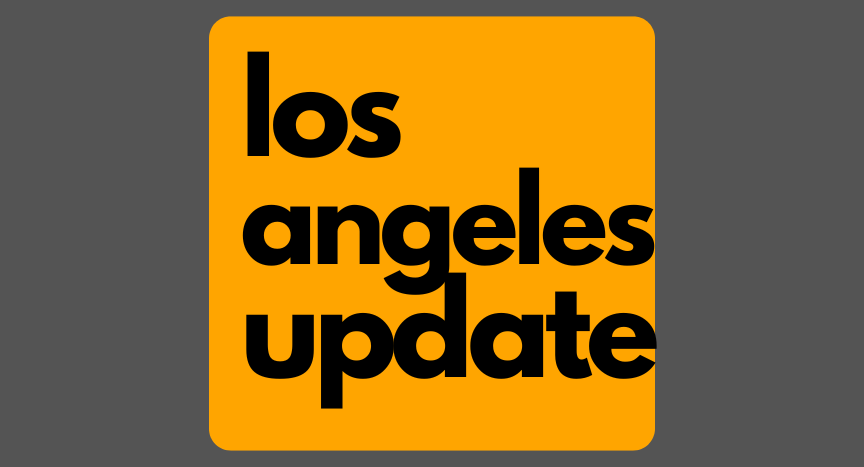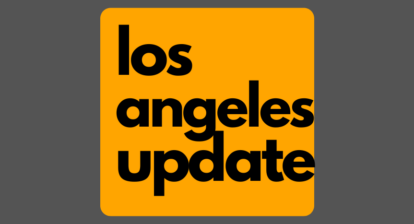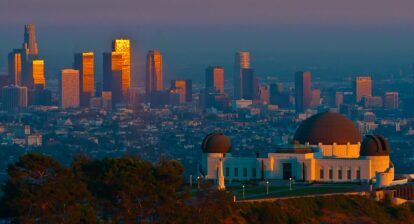Originally deployed by the Trump administration to address “violent, insurrectionist mobs” in and around Los Angeles, U.S. Marines and California National Guard troops have recently found themselves facing little more than boredom.
“There’s not much to do,” a Marine remarked while on guard outside the imposing Wilshire Federal Building in Westwood this week.
The vibrant protests that initially erupted against federal immigration raids in downtown Los Angeles were absent along Wilshire Boulevard or Veteran Avenue, leading many troops to spend their time chatting and joking over energy drinks. The Marine, who requested anonymity due to restrictions on speaking with reporters, indicated that his responsibilities primarily involved granting access to federal workers and visitors at the Veterans Affairs office.
Over five weeks since Trump ordered a significant military presence against the objections of California Gov. Gavin Newsom and L.A. Mayor Karen Bass, most National Guard troops and Marines have vanished from public view, retreating to local military bases in Orange County.
Reflecting the military’s diminishing role in immigration enforcement, U.S. Secretary of Defense Pete Hegseth announced the release of 2,000 National Guard troops on Tuesday. Meanwhile, both Bass and Newsom, along with others, are urging the complete withdrawal of the remaining troops—around 2,000 California National Guard soldiers and 700 Marines.
“Thousands of members are still federalized in Los Angeles for no reason and unable to perform their essential duties across the state,” Newsom stated on X, accusing Trump of using California National Guard troops as “political pawns.”
“Terminate this charade and bring everyone back home,” the governor insisted.
Bass asserted that the troops’ main assignment in L.A. was to secure federal buildings that “honestly didn’t require guarding.”
“They had to separate from their families, education, and jobs,” Bass mentioned at a news conference on Tuesday. “There have been no issues for weeks, so why are they still here?”
Steve Woolford, a resource counselor for GI Rights Hotline, a nonprofit providing free, confidential information to service members, noted that calls from troops have significantly decreased over the past month.
“The last few people I spoke with sounded bored and lacked purpose,” Woolford shared. “They seem fine with it: they’re not asking for more tasks. Yet, I sense they don’t see any genuine purpose in their current activities.”
The bulk of National Guard troops have been allocated to the Joint Forces Training Base in Los Alamitos, according to military officials and members of the governor’s office who spoke under anonymity.
In recent weeks, a large tent city has emerged at the Orange County base—approximately 25 miles southeast of downtown L.A. The tents, some extending up to 50 yards long, serve as living quarters, eating areas, and other facilities. On a recent morning, National Guards troops—some in full combat attire and others in casual wear—were observed exercising, roaming around, and engaging in touch football.
A separate contingent of Marines and National Guard troops has remained stationed at the Westwood federal building for a full month. The building has been equipped with sleeping and dining arrangements for the troops, according to a Marine who communicated with The Times.
It is true that some California National Guard troops participated in tense operations alongside federal immigration agents, conducting sweeps at farms, warehouses, and public streets.
On July 7, Guard troops joined federal agents as they raided MacArthur Park on horseback and in armored vehicles in a heavily militarized display. Although it remains uncertain if any arrests occurred that day, crowds quickly gathered around the federal agents and military personnel, yelling for them to “leave!”
Days later, Guard troops wielding riot face shields and long wooden batons confronted hundreds of demonstrators in Ventura County, as immigration agents apprehended around 200 suspected undocumented immigrants at Glass House Farms, a cannabis greenhouse in Camarillo.
However, the majority of the deployed Guard troops and Marines do not appear to have engaged in raids or even maintained security at federal buildings in recent weeks.
An estimated 90% of the National Guard troops stationed in the L.A. area in recent days have not participated in daily operations, according to a source in Newsom’s office familiar with the military operation.
“For the most part … they’re just sitting around,” the source said.
The source, who spoke under anonymity due to restrictions on public commentary regarding the deployment, estimated that approximately 3% of the 4,000 troops—around 120 soldiers—were involved in daily missions, mostly concerning security at federal buildings.
A few hundred more were on standby for “quick response force” missions—ready to be mobilized within hours for immigration raids or crowd control. However, even with these troops activated daily, about 88% of the 4,000 troops—roughly three-quarters of the remaining 2,000—remained underutilized.
The Pentagon and Task Force 51, the military’s designation for Los Angeles area soldiers, declined to provide information about how many Guard troops and Marines were involved in safeguarding federal buildings or accompanying immigration agents on daily tasks. They did not comment on Newsom’s office’s assertion that most troops were “sitting idle.”
Guard soldiers and Marines were “primarily providing security for fixed-site federal facilities and assisting federal law enforcement personnel while they conduct immigration enforcement activities, such as serving warrants,” read a statement from the task force.
Federal officials have also refrained from disclosing exact costs relating to the deployment. Hegseth previously stated that mobilizing troops would be $134 million, but the accuracy of this estimate remains ambiguous.
Jennifer Kavanagh, director of military analysis at Defense Priorities, a military research organization, emphasized the lack of evidence supporting the necessity of military presence.
“The demand for military forces in Los Angeles is minimal, while the requirement for National Guard forces elsewhere in the state is increasing,” Kavanagh observed. “Remaining deployed for an extended period without apparent need suggests a desire to establish a precedent for military involvement in immigration enforcement and deployment within U.S. urban areas.”
Kori Schake, a senior fellow and director of foreign and defense policy studies at the American Enterprise Institute, concurred: “They have essential training to focus on—fighting and securing the nation’s wars—while this performative policing distracts from that mission.”
The first units of Guard troops arrived in L.A. on June 8, shortly following the Trump administration’s announcement to deploy 2,000 Guard members to the city in response to unrest as protesters tagged buildings, set fire to Waymo driverless cars, and clashed with ICE agents attempting immigration raids.
Despite protests from California leaders deeming the deployment far from necessary, the Trump administration intensified its stance. On June 10, 700 Marines from the Marine Corps Air Ground Combat Center about 150 miles west in Twentynine Palms arrived in L.A. A week later, the task force expanded to 4,800 personnel when Hegseth sent an additional 2,000 Guard troops.
Newsom criticized Trump for redirecting members of the California National Guard as they prepared for wildfire season, citing that the unit dedicated to wildfire response was operating at just 40% of its normal staffing levels due to the deployment. The governor’s office also raised concerns that approximately 150 California Guard soldiers were pulled from the state’s Counterdrug Task Force, focusing on disrupting drug trafficking at the U.S.-Mexico border and throughout California.
Ultimately, the Trump administration authorized the release of 150 Guard members for state wildfire suppression.
While the National Guard has been deployed in Los Angeles before, it has never been against the wishes of the L.A. mayor and California governor.
In 1992, President George H.W. Bush mobilized the National Guard to Los Angeles following several days of riots triggered by a jury’s acquittal of four white police officers in the beating of Black motorist Rodney King. Approximately 6,000 troops were ultimately deployed at the request of then-Gov. Pete Wilson and Mayor Tom Bradley, to secure vulnerable areas and restore control after rioters attacked businesses, set buildings ablaze, and in extreme cases assaulted or killed residents. The Times labeled it “the worst civil unrest in Los Angeles history.”
Nearly 30 years later, Guard troops were summoned once again during the 2020 protests after George Floyd’s murder. Following downtown vandalism and arson of police vehicles, L.A. Mayor Eric Garcetti requested Newsom to deploy 1,000 National Guard troops to assist local law enforcement in restoring order.
However, last month, the federal government sent in the troops without the support of local officials, igniting an intense legal confrontation.
A day after the National Guard troops arrived in L.A., Newsom and Atty. Gen. Rob Bonta filed a lawsuit against the Trump administration to halt the “illegal and unnecessary takeover” of a California National Guard unit. They argued that the unwarranted commandeering of National Guard troops without the governor’s consent violated the U.S. Constitution and exceeded the president’s Title 10 authority.
A U.S. district judge in San Francisco ruled in favor of the state on June 12, determining that Trump violated the law by deploying thousands of California National Guard troops to L.A. contrary to the state’s wishes. The judge issued a temporary restraining order aimed at restoring control of the National Guard to California. However, the U.S. 9th Circuit Court of Appeals paused this order, permitting the troops to remain in L.A. pending the outcome of the federal court case.
Kavanagh expressed concern over Guard troops assisting federal agents during immigration raids. Even if they were instructed not to engage in law enforcement activities, situations could escalate rapidly.
“There are numerous opportunities for things to spiral out of control,” she remarked. “While we haven’t observed any unintended escalation yet, that doesn’t guarantee we won’t.”
When the troops were initially deployed to L.A., advocates for service members expressed concerns about low morale. Woolford noted a surge of calls to the GI Rights Hotline regarding apprehensions about immigration enforcement.
Some personnel communicated to the hotline that they opposed supporting ICE or participating in deportations, considering immigrants part of the community or having immigrant family members. Others expressed reluctance to point weapons at citizens. A few worried that the country might be approaching a state resembling martial law, and expressed a desire not to become the armed occupiers of their own nation.
Many were taken aback that the deployment orders were set for 60 days.
“There’s no way they really intend to keep us here that long, right?” Woolford recalled being asked.
However, as more contractors arrived and large tents with cots were set up, callers to the hotline seemed increasingly resigned to the idea of a prolonged stay in L.A.
When questioned about the pressures faced by troops on their assignment to Los Angeles, a Marine stationed outside the Wilshire Federal Building offered a succinct insight:
“That’s just orders,” he stated. “We follow directions—it’s the system.”
Times staff writer Jeanette Marantos contributed to this report.



